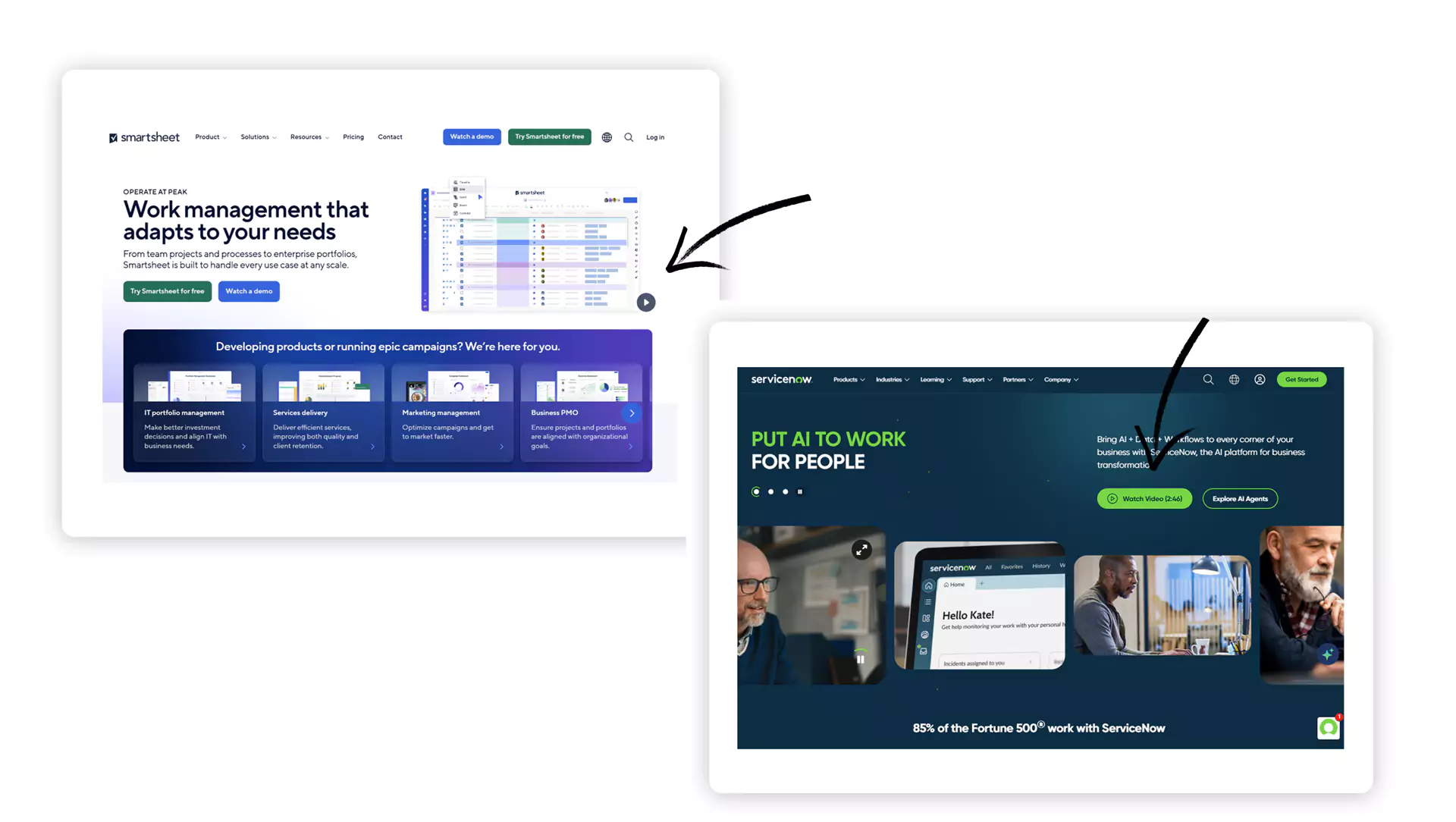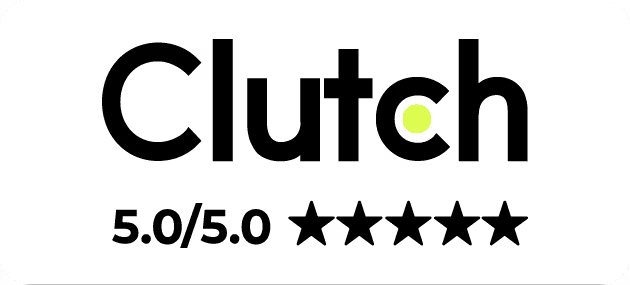Your Website Needs These Videos



7 Seconds. That’s How Long It Takes to Make a First Impression
And when we designed our website, this was part of the brief.
Like anyone, before launching, we scoured different websites looking for ideas to steal (we all do it, right?).
And there was a problem.
Whilst in inspiration mode, we found that most websites still rely on walls of text and stock images to make their first impression.
And naturally, like everyone else, we clicked away before reading them.
They could’ve had the best service in the world, but the first impression was more underwhelming than a pre-packaged sandwich.
So we bounced.
In this resource, I’ll share some of the strategies and inspiration from our own site that helped us make a better first impression with just a handful of videos.
Why Video Keeps People On Your Site
Bounce rates measure “one-and-done” visits – where someone lands on your website, doesn’t click anything, and leaves.
That usually means the page didn’t grab their attention or give them a reason to stick around.
Pages with video content often see an 11% lower bounce rate compared to those without.
Even if that’s a stat we’ve nicked from another video company trying to push video on you, it makes logical sense, doesn’t it?
Would you rather read a load of text, or watch a quick video?
Do you get a better sense of what a team’s about from a stock photo or a video of the actual team?
So, with science and common sense aligned, why do so many sites still rely on just text and stock images?
Probably because that’s what’s easiest for web developers who don’t do video. Over time, that just becomes the way it’s done. It becomes a template style, rolled out across loads of B2B websites.
It takes a breakthrough brand to come along and ask, “Shouldn’t we have a video there instead?”
And plenty of them are. Lots of breakthrough B2B brands are placing video front and centre. We’re one of them.
The good news is, we’ve got a short little blueprint for you to follow here, with reference to our own videos and other brands showing the way.
Building Your Video Growth Engine
“Growth.” Urgh. Not a word that conjures up the greatest mental images, right? Unless it’s combined with words like “business” or “revenue”. Then it sounds downright sexy.
We’ve studied ambitious brands and developed a video growth system that helps B2B businesses grow in a way that’s repeatable and sustainable.
“Systems are best for making progress.” — James Clear
Video can be a headache to manage. We’ve seen that first-hand and made the same mistakes ourselves.
So we took a step back and studied the B2B brands that actually broke through. We looked at how they used video to build trust, drive sales, and grow.
Then we combined that insight with our own experience and built what we now call the Video Growth Engine.
It works like any engine. Different parts, doing different jobs, all working together to deliver consistent results.
If you’ve not got any video on your site yet, the build should always start with the core video assets your business needs. Once they’re in place, you can make a bigger engine and make it go faster.
(OK, no more engine puns. TURBO BOOST! OK, that’s the last one, I promise.)
The point is, it’s scalable. But to stop it feeling overwhelming, here are three videos almost every B2B business should start with:
Why You Need a Company Intro Video
Think about it.
If you had no attachment to a brand, would you rather scroll through an entire website, clicking every page and reading every section, or just watch a quick video?
Exactly. We’d all go for the video.
As business owners, it’s easy to overestimate how important we are. And that’s fair. You’re proud of what you’ve built.
But the reality is, in most industries, clients have options. Plenty of providers are saying similar things, and it’s hard to stand out.
What matters most is being memorable. When the time comes to buy, you want your name to be the one they remember.
That’s where your Company Intro Video comes in.
We like to call it the “Why Care?” video.
At this stage, a potential client might be:
Having a quick look after hearing your name
Checking you out after a recommendation
Snooping around after seeing one of your posts
They’re not bought in yet. They’re in research mode, scanning and comparing before they share what they’ve found with the decision-maker.
Your intro video’s job is simple. Grab their attention and show them why they should stick around.
No surprise that the best-performing B2B brands all have one.

They make their company intro video one of the first things visitors see. It’s often placed above the fold, or just below the main call to action.
It quickly builds credibility and keeps people interested without them needing to scroll.
Here's Ours
Why You Need a How It Works Video
The B2B buying journey is different to B2C.
B2C can be as simple as doomscrolling TikTok and suddenly buying a mini waffle maker.
B2B is (thankfully) more considered.
That means lots of discovery. Often, the person doing the research has to compile options for a decision-maker or justify their recommendation to a board.
So the more clarity you give about what happens when they book a call, or buy what you sell, the better.
This can be more detailed than the intro. It helps remove any uncertainty and shows the end-to-end process, or at least the broad steps most clients go through.
The viewer feels more confident. They know what to expect. They can report back to their boss or confidently put you forward as an option, knowing you sound legit and look like a good fit.
We call this a sales-friction reducing asset.
Long name, but it just means it helps people understand you better when they’re nearly ready to buy, but not quite ready to get in touch.
Databricks do this well with video:
https://youtu.be/AHeauDwaxjc
We placed our version on our Services page. Rather than forcing visitors to read through every line of copy, they can just watch.
Here it is
Meet the Team / About Us
You’ve probably got an About Us page on your site.
It probably says something like “We’re not like other teams”. There might be a few lines about your values, followed by headshots and bios.
We’ve all seen them.
We wanted to do something more watchable.
So we made a short video to show off the people behind the business.
Here it is
The idea was to let prospects see who they’d be working with. Are we their kind of people? Do we look like we care? Do we sound like a team they’d trust?
And if you’ve got an interesting origin story, even better. That’s a brilliant way to connect and show why your business exists.
Think about Apple, Canva or Nike. You don’t just like the products. You connect with their founders, their drive, their story.
B2B tends to be slow to catch up. But stories are powerful. They tap into something deeper than a sales pitch.
They build a connection that’s harder to forget.
Dropbox does this brilliantly
Takeaways
If your current first impression is just text and stock images, don’t worry. You’re not the only one.
But if you want people to actually stick around, video is one of the easiest upgrades you can make.
Start with three videos:
- A Company Intro – give people a reason to care.
- A How It Works – make the sales process feel easy and low-pressure.
- A Meet the Team – show them the real people they’ll be working with.
Small changes. Big difference.
Check out our own site to see them in action. Then get in touch if you want help building your own video growth engine.
don't miss a beat
Subscribe to our newsletter and Keep up to date on the latest resources we release.
Featured resources
Your Website Needs These Videos

From company intro to how-it-works, this guide shows what content high-performing websites use to stand out and convert.

Why Most Adverts Don’t Work

Most ads get ignored. Here’s how brands are swapping forgettable campaigns for content people want to watch.

A Guide to Starting Your Own Podcast

Lessons from launching The Overlap and High Performance, and how to make your podcast last.


